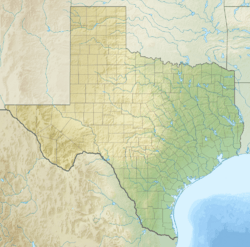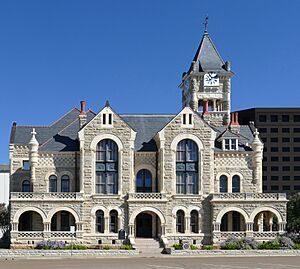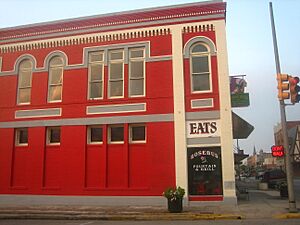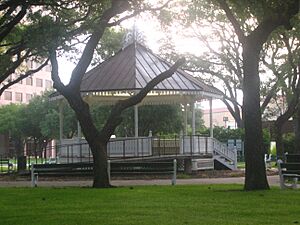Victoria, Texas facts for kids
Quick facts for kids
Victoria, Texas
|
||
|---|---|---|
|
City and county seat
|
||
| City of Victoria | ||
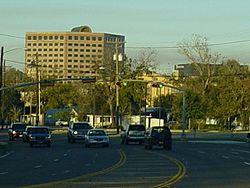
Downtown Victoria in December 2007
|
||
|
||
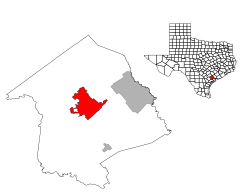
Location in the state of Texas
|
||
| Country | ||
| State | ||
| County | Victoria | |
| Government | ||
| • Type | Council–manager | |
| Area | ||
| • City and county seat | 37.57 sq mi (97.30 km2) | |
| • Land | 37.37 sq mi (96.78 km2) | |
| • Water | 0.20 sq mi (0.52 km2) | |
| Elevation | 95 ft (29 m) | |
| Population
(2020)
|
||
| • City and county seat | 65,534 | |
| • Density | 1,790.73/sq mi (691.41/km2) | |
| • Metro | 116,000 | |
| Time zone | UTC−6 (CST) | |
| • Summer (DST) | UTC−5 (CDT) | |
| ZIP code(s) |
77901, 77902, 77903, 77904, 77905
|
|
| Area code(s) | 361 | |
| FIPS code | 48-75428 | |
| GNIS feature ID | 1370631 | |
| Website | City of Victoria | |
Victoria is a city in Texas, United States. It is the main city of Victoria County, Texas. In 2020, about 65,534 people lived there. The larger area around Victoria had about 111,163 people in 2000.
Victoria is located about 30 miles (48 km) from the Gulf of Mexico. It is a two-hour drive from big cities like Corpus Christi, Houston, San Antonio, and Austin.
The city is named after Guadalupe Victoria. He was the first president of independent Mexico. Victoria is also home to the main church for the Roman Catholic Diocese of Victoria in Texas.
Contents
Discovering Victoria's Past
The city of Guadalupe Victoria was started in 1824 by Martín De León. He was a Mexican empresario, which means he helped bring settlers to Texas. He named the city to honor Guadalupe Victoria. Victoria was part of De León's Colony at first. By 1834, about 300 people lived there.
During the Texas Revolution, Victoria helped the Texans fighting for independence. But after a battle, the Mexican army took over the town. When the Mexican army was defeated, Anglo settlers moved in. They changed the city's name to Victoria.
In 1840, a Comanche raid on nearby Linnville caused many deaths. A serious sickness called cholera also spread in 1846.
In the mid-1800s, many European immigrants, especially Germans, came to Victoria. By the early 1900s, Victoria grew quickly. It became an important trading center for the region. Its location near Gulf Coast ports and big cities helped it grow. Farming and the petrochemical industry also made it strong.
The University of Houston–Victoria was started in 1971. It is still an important part of the city today.
In 2017, the Victoria Islamic Center mosque was sadly destroyed by fire. A local man was found guilty of setting the fire. A movie called A Town Called Victoria was made about this event.
Victoria's Natural Surroundings
Victoria is on the flat coastal plains of Texas. It is about 50 miles (80 km) from the Gulf of Mexico. The Guadalupe River flows nearby. The land is mostly flat, with an average height of 95 feet (29 m). The soil is mostly clay, which can be tricky for buildings. The area has short grasses and small trees. Wetter areas have taller forests with elm and pecan trees.
Victoria's Weather Patterns
Victoria has a humid subtropical climate. This means it has hot, humid summers and mild winters. From June to August, temperatures often go above 100°F (38°C). The highest temperature ever recorded was 111°F (44°C) in September 2000. Victoria also holds the Texas record for October, with 109°F (43°C) in 1926.
Spring and autumn are usually warm and less humid. Winters are mild, but sometimes it gets cold. The lowest temperature ever recorded was 9°F (-13°C) in December 1989. Snow is very rare, happening about once every 11 years. On Christmas Eve and Christmas Day in 2004, Victoria had its first "White Christmas" with 12.5 inches (32 cm) of snow.
Rainfall is lowest in winter and in August. The wettest months are usually May, June, September, and October. This is because of tropical storms and hurricanes, which can bring a lot of rain.
Victoria can have severe weather, especially floods. Hurricanes can cause a lot of damage. Hurricane Claudette hit the city directly in July 2003. Winds reached 83 mph (134 km/h), and most of the city lost power. The strongest hurricane to affect Victoria was Hurricane Carla in September 1961.
In May 2013, a rare tornado touched down northeast of Victoria. It did not hit any buildings or cause injuries. Tornadoes in this area are usually linked to hurricanes and are otherwise uncommon.
| Climate data for Victoria Regional Airport, Texas (1981–2010 normals, extremes 1902–present) | |||||||||||||
|---|---|---|---|---|---|---|---|---|---|---|---|---|---|
| Month | Jan | Feb | Mar | Apr | May | Jun | Jul | Aug | Sep | Oct | Nov | Dec | Year |
| Record high °F (°C) | 88 (31) |
96 (36) |
99 (37) |
100 (38) |
102 (39) |
109 (43) |
110 (43) |
109 (43) |
111 (44) |
109 (43) |
93 (34) |
88 (31) |
111 (44) |
| Mean maximum °F (°C) | 79.4 (26.3) |
82.9 (28.3) |
86.5 (30.3) |
89.5 (31.9) |
93.9 (34.4) |
96.9 (36.1) |
98.5 (36.9) |
100.5 (38.1) |
97.5 (36.4) |
92.8 (33.8) |
86.2 (30.1) |
81.1 (27.3) |
101.3 (38.5) |
| Mean daily maximum °F (°C) | 64.7 (18.2) |
68.1 (20.1) |
74.2 (23.4) |
80.5 (26.9) |
86.5 (30.3) |
91.5 (33.1) |
93.8 (34.3) |
95.0 (35.0) |
90.4 (32.4) |
83.5 (28.6) |
74.2 (23.4) |
66.1 (18.9) |
80.8 (27.1) |
| Mean daily minimum °F (°C) | 43.1 (6.2) |
46.4 (8.0) |
52.5 (11.4) |
59.3 (15.2) |
67.3 (19.6) |
72.4 (22.4) |
74.0 (23.3) |
73.7 (23.2) |
69.2 (20.7) |
60.9 (16.1) |
51.8 (11.0) |
44.3 (6.8) |
59.6 (15.3) |
| Mean minimum °F (°C) | 27.6 (−2.4) |
30.1 (−1.1) |
34.5 (1.4) |
43.5 (6.4) |
55.3 (12.9) |
65.8 (18.8) |
70.3 (21.3) |
69.8 (21.0) |
56.4 (13.6) |
44.4 (6.9) |
35.4 (1.9) |
27.3 (−2.6) |
23.5 (−4.7) |
| Record low °F (°C) | 9 (−13) |
13 (−11) |
21 (−6) |
33 (1) |
45 (7) |
54 (12) |
61 (16) |
61 (16) |
45 (7) |
31 (−1) |
18 (−8) |
9 (−13) |
9 (−13) |
| Average precipitation inches (mm) | 2.52 (64) |
2.08 (53) |
2.77 (70) |
2.82 (72) |
5.19 (132) |
4.46 (113) |
4.18 (106) |
2.85 (72) |
4.16 (106) |
4.64 (118) |
3.24 (82) |
2.31 (59) |
41.22 (1,047) |
| Average snowfall inches (cm) | 0.1 (0.25) |
0.1 (0.25) |
trace | 0.0 (0.0) |
0.0 (0.0) |
0.0 (0.0) |
0.0 (0.0) |
0.0 (0.0) |
0.0 (0.0) |
0.0 (0.0) |
trace | 0.3 (0.76) |
0.4 (1.0) |
| Average precipitation days (≥ 0.01 in) | 8.4 | 8.1 | 7.1 | 6.1 | 7.1 | 8.9 | 7.9 | 8.1 | 9.5 | 7.6 | 7.3 | 8.1 | 94.2 |
| Source: NOAA | |||||||||||||
People Living in Victoria
| Historical population | |||
|---|---|---|---|
| Census | Pop. | %± | |
| 1850 | 806 | — | |
| 1860 | 1,986 | 146.4% | |
| 1870 | 2,534 | 27.6% | |
| 1890 | 3,046 | — | |
| 1900 | 4,010 | 31.6% | |
| 1910 | 3,673 | −8.4% | |
| 1920 | 5,957 | 62.2% | |
| 1930 | 7,421 | 24.6% | |
| 1940 | 11,566 | 55.9% | |
| 1950 | 16,126 | 39.4% | |
| 1960 | 33,047 | 104.9% | |
| 1970 | 41,349 | 25.1% | |
| 1980 | 50,695 | 22.6% | |
| 1990 | 55,076 | 8.6% | |
| 2000 | 60,603 | 10.0% | |
| 2010 | 62,592 | 3.3% | |
| 2020 | 65,534 | 4.7% | |
| U.S. Decennial Census | |||
| Race | Number | Percentage |
|---|---|---|
| White (NH) | 23,953 | 36.55% |
| Black or African American (NH) | 4,655 | 7.1% |
| Native American or Alaska Native (NH) | 158 | 0.24% |
| Asian (NH) | 1,337 | 2.04% |
| Pacific Islander (NH) | 27 | 0.04% |
| Some Other Race (NH) | 163 | 0.25% |
| Mixed/Multi-Racial (NH) | 1,303 | 1.99% |
| Hispanic or Latino | 33,938 | 51.79% |
| Total | 65,534 |
In 2020, Victoria had 65,534 people. There were 23,724 households and 15,560 families. In 2000, the city had 60,603 people.
About 36.1% of households in 2000 had children under 18. About 52.4% were married couples. Around 24.5% of households had one person living alone. The average household had 2.68 people.
In 2000, about 28.8% of the population was under 18. About 12.6% were 65 or older. The average age was 34 years.
Victoria's Economy
Victoria's economy includes education, health, shopping, farming, and industry. Its location helps businesses grow. It has access to major highways, the Victoria Regional Airport, and railway lines. It also has the shallow Port of Victoria and the deep water Port of Port Lavaca-Point Comfort.
Big companies like Formosa Plastics Corp, Inteplast Group, Dow, Invista, Caterpillar, and Alcoa have operations here.
Arts, Culture, and Fun in Victoria
Theatre Victoria puts on six shows each season. These include performances by the Victoria Symphony Orchestra and the Victoria Ballet.
The Victoria Bach Festival happens every June.
You can visit several museums in Victoria. These include the McNamara House, which shows local history. The Nave is an art museum. There is also the Children's Discovery Museum and the Museum of the Coastal Bend.
The Victoria Art League is a place for local artists. It is in a building that is a Texas Registered Historical Landmark.
DeLeon Plaza and Bandstand was one of the first public squares in the city. It has monuments and a bandstand built in 1890.
The Victoria County Courthouse was built in 1892. It is made of Texas granite and Indiana limestone.
Fossati's Delicatessen in downtown Victoria opened in 1882. It is a very old and famous deli.
Downtown Victoria also has St. Mary's Church. It is the second-oldest Roman Catholic Church in Texas. It was the first one officially recognized in the Republic of Texas.
Parks and Recreation
Victoria's Riverside Park is very large, covering 562 acres (2.27 km2). It is home to the Texas Zoo. The zoo has over 200 types of animals and plants native to Texas. They are shown in their natural homes. The park also has more than 15 baseball fields. These fields are busy with teams in the spring and summer. The Victoria Paddling trail is also in Riverside Park on the Guadalupe River. This 4.2-mile (6.8 km) trail is great for paddling.
You can go boating and fishing at two nearby lakes: Lake Texana and Coleto Lake. Many people also enjoy the nearby Gulf of Mexico. Port O'Connor, about 50 miles (80 km) away, is famous for fishing in the bay and offshore.
Victoria has three golf courses: the Victoria Country Club, Riverside Golf Course, and Colony Creek Country Club.
The main shopping center in the city is Victoria Mall.
Sports in Victoria
The UHV Jaguars are college sports teams. They play baseball, softball, soccer, and golf. They are part of the Red River Athletic Conference in the NAIA Division I.
The Victoria Generals play in the Texas Collegiate League. This is a summer baseball league. The Generals won the league championship in 2010.
Learning in Victoria
The Victoria Independent School District serves the city's public schools. Victoria also has several private schools. These include Trinity Episcopal School, Faith Academy, Northside Baptist School, Our Lady of Victory School, Nazareth Academy, and St. Joseph High School.
For higher education, there is Victoria College. This is a two-year community college. The University of Houston–Victoria is a four-year university campus.
Media and News
Newspapers
The daily newspaper in Victoria is The Victoria Advocate. The University of Houston–Victoria also publishes a newspaper called The Flame.
Radio Stations
Victoria has many radio stations that offer different types of music and talk shows.
Television Stations
Victoria has several local TV stations.
- KMOL-LD (channel 17) is Victoria's NBC station.
- KVCT (channel 19) is Victoria's Fox station.
- KUNU-LD (channel 21) is Victoria's Univision station.
- KAVU-TV (channel 25) is Victoria's ABC station. It also shows NBC and CBS programs on other channels.
- KQZY-LD (channel 33) shows Cozi TV.
- KXTS-LD (channel 41) is Victoria's CBS station.
- KVTX-LD (channel 45) is Victoria's Telemundo station.
PBS programs are available from stations in Houston (KUHT, channel 8) and San Antonio (KLRN, channel 9).
Getting Around Victoria
Victoria is located where three major U.S. highways meet. These highways help people travel to and from the city.
- US Highway 59 (also known as I-69 and I-69W) is a four-lane highway. It goes southwest to Laredo and northeast to Houston. This highway is planned to become part of the future Interstate 69 system.
- US Highway 77 (also known as I-69E) goes north from Victoria to the Dallas–Fort Worth area. It also goes south to the Rio Grande Valley. This highway is planned to become part of the future Interstate 69E.
- US Highway 87 goes northwest to San Antonio. It also connects to Port Lavaca to the southeast.
 US 59
US 59





 Future I-69 / Future I-69W
Future I-69 / Future I-69W
 US 77
US 77



 Future I-69E
Future I-69E
 US 87
US 87 SH 185
SH 185
Victoria is a hub for transportation in the area. It has access to major freight carriers, the Victoria Regional Airport, and railway terminals. It also has the shallow Port of Victoria and the deep water Port of Port Lavaca – Point Comfort.
In 2002, Victoria Transit started a city bus service. It has four routes with 70 stops around the city.
Famous People from Victoria
Many notable people have connections to Victoria:
- Joe Beaver – An 8-time Rodeo World Champion and member of the ProRodeo Hall of Fame.
- Stone Cold Steve Austin (born 1964) – A famous wrestler and actor.
- Cowboy Troy (Troy Lee Coleman III) – A country music singer.
- Doug Drabek – A former MLB pitcher who won the 1990 Cy Young Award.
- Kyle Drabek – A former MLB pitcher.
- Ron Gant – A former MLB outfielder.
- Kevin Kolb – A former NFL quarterback.
- Michale Kyser (born 1991) – A basketball player.
- Frankie Miller (born 1931) – A country musician.
- Matt Prokop (born 1990) – An actor.
- Joseph Rojas – The lead singer of the band Seventh Day Slumber.
- Jerheme Urban – A former NFL wide receiver.
- Noël Wells (born 1986) – An actress.
- Bailey Zappe – An NFL quarterback.
See also
 In Spanish: Victoria (Texas) para niños
In Spanish: Victoria (Texas) para niños



